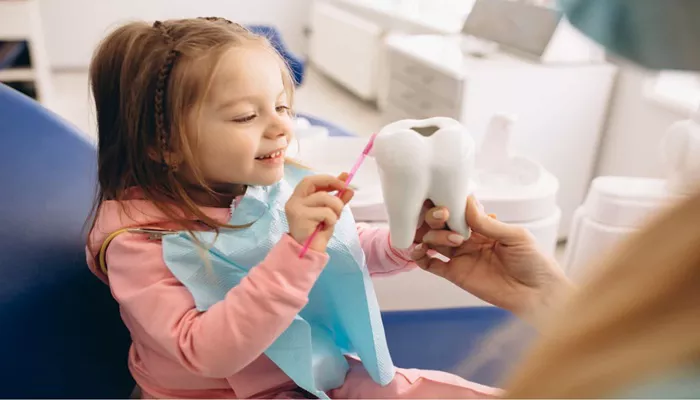Pediatric dentistry and orthodontics are two vital branches of dental care, each focusing on different aspects of oral health.
While both fields aim to ensure the well-being of patients, they cater to distinct needs and populations. This article will explore the key differences between pediatric dentistry and orthodontics, including their definitions, areas of focus, training requirements, and how they work together to promote children’s oral health.
What Is Pediatric Dentistry?
Pediatric dentistry is a specialized field that focuses on the oral health of infants, children, adolescents, and those with special healthcare needs. Pediatric dentists are trained to handle the unique dental requirements of young patients, which include both preventive and therapeutic care. Their primary responsibilities encompass:
Routine Check-Ups: Pediatric dentists conduct regular examinations to monitor the development of baby and permanent teeth.
Preventive Care: They provide education on proper oral hygiene practices and dietary choices that promote healthy teeth.
Restorative Procedures: Pediatric dentists perform treatments such as fillings for cavities, crowns for damaged teeth, and extractions when necessary.
Management of Dental Anxiety: They are skilled in techniques to help manage anxiety in young patients, making visits less stressful.
To become a pediatric dentist, one must complete a general dental degree followed by an additional two to three years of specialized training in pediatric dentistry. This training equips them with the knowledge to address not only dental issues but also the psychological and developmental aspects of treating children.
What Is Orthodontics?
Orthodontics is a specialized branch of dentistry that focuses on diagnosing, preventing, and treating dental and facial irregularities.
Orthodontists work primarily with braces, aligners, and other devices to correct misalignments in teeth and jaws. Their main responsibilities include:
Diagnosis of Malocclusions: Orthodontists assess bite issues such as overbites, underbites, crossbites, and overcrowding.
Treatment Planning: They develop comprehensive treatment plans tailored to individual patients’ needs.
Use of Appliances: Orthodontists utilize various appliances like braces or clear aligners to gradually move teeth into proper alignment.
Monitoring Progress: Regular follow-up appointments are essential to adjust appliances as needed throughout the treatment process.
To practice orthodontics, a dentist must first complete a dental degree followed by an additional two to three years in an orthodontic residency program. This advanced training focuses on tooth movement mechanics and facial development.
Key Differences Between Pediatric Dentistry And Orthodontics
While both pediatric dentists and orthodontists play crucial roles in maintaining oral health for children, their focus areas differ significantly:
| Aspect | Pediatric Dentistry | Orthodontics |
| Focus Area | General oral health care for children | Correction of teeth and jaw alignment |
| Age Group | Infants to adolescents | Primarily adolescents but can treat adults too |
| Types of Services | Preventive care, restorative treatments | Braces, aligners, jaw surgery |
| Training Duration | 2-3 years post-dental degree | 2-3 years post-dental degree |
| Common Procedures | Cleanings, fillings, extractions | Fitting braces, creating retainers |
Collaboration Between Pediatric Dentists And Orthodontists
Pediatric dentists often play a crucial role in identifying potential orthodontic issues early in a child’s development. During routine check-ups, they can detect signs that may require orthodontic intervention later on. This early detection allows for timely referrals to orthodontists when necessary.
For example:
If a pediatric dentist notices overcrowding or misalignment during an examination, they may refer the child to an orthodontist for further evaluation.
Conversely, orthodontists may refer patients back to pediatric dentists for routine care or if any dental issues arise during orthodontic treatment.
This collaborative approach ensures that children receive comprehensive care tailored to their evolving needs.
Importance of Early Intervention
Both pediatric dentists and orthodontists emphasize the importance of early intervention in dental care. For pediatric dentists, this means monitoring the growth of teeth and jaws from an early age. For orthodontists, early intervention can lead to more effective treatments with shorter durations.
Early assessments can lead to:
Simplified Treatment Plans: Addressing issues like overcrowding while permanent teeth are still emerging can simplify future treatments.
Prevention of Complex Issues: By identifying problems early on, both specialists can help prevent more severe complications that may require extensive treatment later.
Conclusion
In summary, pediatric dentistry and orthodontics serve distinct yet complementary roles in maintaining children’s oral health. Pediatric dentists focus on overall dental care for children from infancy through adolescence while addressing preventive measures and restorative needs. In contrast, orthodontists specialize in correcting misalignments of teeth and jaws through targeted treatments.
Understanding these differences is crucial for parents seeking appropriate dental care for their children. By fostering collaboration between these two specialties, families can ensure that their children’s oral health is managed effectively at every stage of development.

